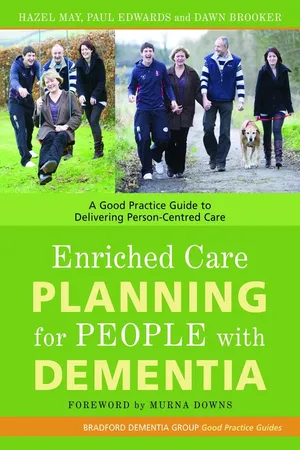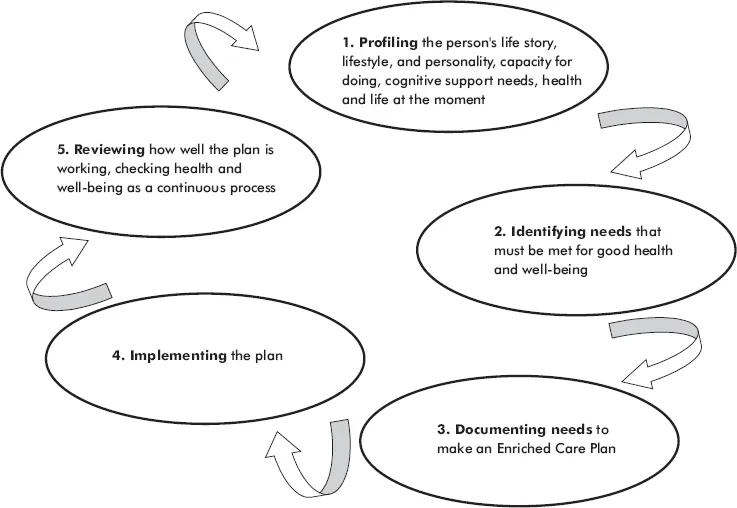Chapter 1
What is Enriched Care Planning?
ENRICHED CARE PLANNING – A MEANS TO AN END
Enriched care planning is a means to an end which is delivering person-centred care. Person-centred care is care that values people regardless of age or cognitive ability; is individualised recognising that each individual is unique; includes the perspective of the person with dementia as central to all care planning; values the person as being able to live a life that has meaning and provides a supportive social environment to enable people to experience relationships (Brooker 2006).
This definition of person-centred care describes four essential elements:
1.Valuing people with dementia and those who care for them; promoting their citizenship rights and entitlements regardless of age or cognitive impairment or ability.
2.Treating people as individuals; appreciating that all people have a unique history and personality, physical and mental health and social and economic resources.
3.Looking at the world from the perspective of the person and listening to their ‘voice’, recognising that each person’s experience has its own psychological validity, that people act from their own perspective, and that empathy with the individual’s perspective has its own therapeutic potential.
4.Recognising that all human life is grounded in relationships and that people need to live in a social environment which both compensates for their impairment and fosters opportunities for personal growth.
A good way to describe and talk about these four elements of person-centred care is to use VIPS (Very Important Persons) as a memory jogger because these letters are also the first letters for Valuing, Individuals, Perspective and Social.
PERSON-CENTRED CARE BRINGS WELL-BEING
Well-being is about how a person is faring generally in this current phase of life and means feeling relatively calm, comfortable and at peace. Ill-being means being disengaged and experiencing predominantly negative mood states. Living with dementia does not inevitably result in ill-being; it is more likely that inadequate care delivered in a culture where physical tasks are valued but relationships between the person and their carer(s) are not causes ill-being. (Edvardsson, Winblad and Sandman 2008). In our research and practice development work with the Bradford Dementia Group, we see many people who have dementia experiencing well-being when person-centred care is delivered (Ballard et al. 2001; Brooker, Woolley and Lee 2007; Surr 2006).
THE FOCUS FOR PERSON-CENTRED CARERS
Person-centred care is more than being nice or being kind; it requires the whole community of people in which the person with dementia is living to pay special attention to the quality of all relationships, to preserving personhood, promoting inclusion, reducing disability and responding to behaviour on the basis that something important is being communicated.
Relationships
Giving and receiving care is emotional and this applies to the relationships between people who have dementia and those in the role of providing support. How people who have dementia and their carers interact and get along together has a significant effect on the well-being of both parties. The enriched care planning approach takes this seriously and provides a structure for exploring the quality of ‘life at the moment’ for the person who has dementia.
Preserving personhood
A crucial aspect of being person centred is helping each person to continue to engage with their world so that their sense of self, of personhood and their inner world is kept intact. This means that carers need to find ways of maximising opportunities for engagement so that each individual experiences themselves as being alive and being a person – belonging to the ‘personhood club’. This might simply involve maintaining eye contact while helping the person to eat food or knowing the person’s life story and using this information to develop a relationship. This degree of individual attention to detail is part of enriched care planning.
Inclusion
In a person-centred care setting, part of the carer’s role is to make sure that each individual is brought into the social world rather than just leaving this to chance. This is achieved either verbally with welcomes and invitations to join in through the day or non-verbally by beckoning, holding hands, making eye contact. The goal is to make each person feel that they are accepted as an individual and that they belong in the community.
Contrary to what people might think, people who have dementia can communicate views and feelings about what is happening in their lives (Alzheimer’s Society 2008; Barnett 2000; Brod et al. 1999; Mozley et al. 1999). Person-centred care should be negotiated and agreed openly and in collaboration with the person who has dementia. When using the enriched care planning approach, care staff and/or family members are guided to work in direct partnership with the person who has dementia.
Reducing disability
Disability for the person who has dementia is brought about by the interplay between the person’s impairment and their environment. Adaptations to the environment, including the way in which the person is approached and communicated with, can dramatically reduce needless disability caused by a poor care environment. For example, uplift lighting does not cast shadows and for somebody with visual impairment (which is the case for some people who have dementia) this kind of lighting can reduce feelings of fear and distress brought on by being unable to process the sudden appearance of dark shadows. Similarly, when a carer adopts a running commentary which is a simple talking description of what is happening, a person with short-term memory impairment is less likely to feel disorientated and anxious. These are both examples of adaptations that may be appropriate when delivering person-centred care. An Enriched Care Plan will include clear descriptions of adaptations like these that the carer(s) need to make to maximise comfort and promote independence and activity for the person who has dementia.
Believing that all behaviour has meaning
Communication is a fundamental human need and we are all born with a powerful and innate need to connect with the world in which we live. When a person’s verbal skills deteriorate their actions can become a vital way of communicating and remaining connected to the world around and many people who have dementia have to rely more on using actions or behaviour to do this. What is so often termed as ‘challenging behaviour’ in many care settings is more likely to be understood as an expression of physical or emotional discomfort in a person-centred one. Enriched care planning takes account of this, values all behaviour as being meaningful and will produce a support or care plan that seeks to find out more about why a person is behaving in a certain way, or documents clear person-centred and individualised responses to expressions of discomfort such as calling out, weeping, sleeping excessively or repetitive self-stimulation.
ENRICHED CARE PLANNING – A PROCESS
Enriched care planning has been developed as a direct result of using the Enriched Model of Dementia (Kitwood 1997) in dementia care settings around the UK. We have used the model to help workforce teams to move forward from old culture to new culture practice. Old culture practice arises from a one-dimensional view of dementia which pre-judges all that the person says and does as a consequence of having a mind that no longer functions properly. This stance opens the door for all sorts of inappropriate and inadequate approaches and responses that can at best only be described as depersonalising.
The enriched model is a psychosocial model that gives equal importance to the neurological, physiological, psychological and sociological components of human existence. All of these factors have an effect on the experience of dementia. The components of the Enriched Model of Dementia are health, life story, personality, neurological impairment and social psychology which is another way of describing the social and psychological quality of ‘life at the moment’. Enriched care planning provides a framework for helping the person who has dementia and their carer(s) to consider each of these in detail as a basis for identifying and meeting current needs.
The Enriched Model of Dementia and its relationship to the Enriched Care Planning Framework is illustrated in Figure 1.1.
Enriched care planning is not just a one-off event, it is a process that takes time and care and it should be ongoing, rather like building a house. If the house is well designed with strong foundations it will be lasting and fit for purpose. Enriched care planning provides a good design and strong foundations for delivering person-centred care.
Enriched care planning involves five stages, as illustrated in Figure 1.2.
Figure 1.1: The Enriched Model of Dementia and its relationship to the Enriched Care Planning Framework
Figure 1.2: The five stages of enriched care planning
ENRICHED CARE PLANNING IS COMMUNICATION
Enriched care planning is more than a paper exercise; writing things down is only part of the process. The final product, the Enriched Care Plan will only be of value if you have communicated directly with the person for whom the care plan has been made. It is important to communicate in a way that you and the person being profiled are both comfortable with and make sure that the quality and quantity of information you collect is ‘fit for purpose’ in this case meaning that it can form the basis of an uncomplicated and achievable care plan.
The process of profiling can take a long time, and should be ongoing. It is not necessary or always appropriate to set up a formal interview although this can sometimes be helpful if a person is new to the care setting or if their needs have suddenly changed. Even so, this would only be a start; more information can be collected informal...


